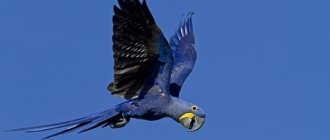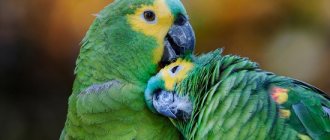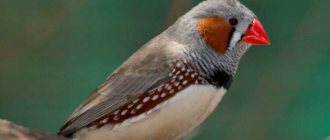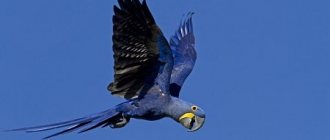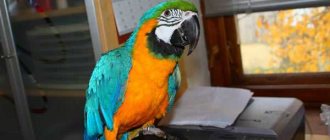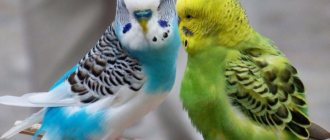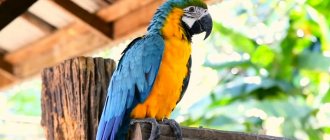Review author: “ZooVita”
Parrots are the most common birds that are used by humans not for hunting, but only for decorative purposes. The names of parrots are as varied as their appearance.
Living in tropical countries, these unusual birds are divided into more than three hundred species. There are species of talking parrots that can repeat heard sounds and even human speech.
Appearance and structure
Descriptions of parrots of different species vary extremely. Their length can range from 9.5 centimeters to one meter. The bird has a great variety of feather color options. The colors of parrots are very bright, and the colored areas are sharply demarcated. Basically the predominant color is green. Juveniles of the same species are, in most cases, identical in color.
The most outstanding feature of parrots is their beak. Its height is twice its width, and often its length. With the help of their unique beak, parrots can not only break hard fruits, but also use it to climb trees, clinging to branches, while actually replacing the bird’s third leg.
The bird's legs, short, thick and with feathers reaching to the heels, are used by parrots both for grasping tree branches and for delivering food to the beak. The parrot's claws are very weak.
Having large wings with wide fans, the parrot is capable of fast flight, but over short distances.
The size of the bird's brain allows it to have a good memory, and its developed vocal muscles contribute to onomatopoeia.
Cockatiel diseases
If the parrot begins to constantly itch, its plumage has become dull and ruffled, it sits ruffled, does not react to others, has become indifferent and inactive, sleeps a lot, refuses to eat and bathe, it has nasal discharge, uneven breathing, growths on its beak and paws - it means something is wrong with his pet.
Diseases of cockatiels that were identified and diagnosed in time are much easier to treat. The Corella parrot is susceptible to the following diseases: digestive and intestinal disorders, colds, conjunctivitis, inflammation of the goiter, feather loss, skin dermatitis, vitamin deficiency, tumors and parasites.
If you notice any of the above symptoms, contact your veterinarian or ornithologist immediately. For a cockatiel to live long and be healthy, it requires good care, proper maintenance and a balanced diet.
Love your pets, don’t forget to look after their health, and then the joy they give us every day will last for many years. If you liked this article, subscribe to site updates to be the first to receive only the latest and most useful articles about animals.
Don't forget to share with your friends!
Habitat territories
The habitat of this exotic bird is extremely wide. Preferably lives in tropical and subtropical climates. The largest population lives in Australia, the bird's probable homeland. Also common in Asia, India, Africa, South and Central America.
But lovers of warm countries, parrots, are also found in more extreme conditions, for example, at an altitude of more than 4 thousand meters in the Andes.
Also, birds that have undergone acclimatization have inhabited the territory of Western Europe, where their large flocks exceed several thousand individuals.
Varieties of parrots
There are many varieties of the popular beautiful bird. The photo of parrots shows the most common representatives:
Please note ⭐⭐⭐
Domestic duck: varieties and rules for caring for them, how to breed ducks at home
Domestic hedgehog: rules for keeping it at home, tips for choosing an animal (120 photos)
Domestic ferret (ferret): features of keeping and caring for the animal, standards, types of breeds, what they eat, how long they live (photo)
Macaw
A large parrot reaching a length of 95 centimeters, it has brightly colored plumage of various tones. A distinctive feature of the bird is its large curved beak, which is the strongest on earth.
The macaw chose Central and South America as its habitat. They live in flocks, inhabiting tropical forests. Pairs created by birds exist for years.
Kakapo, or owl parrot
0
Kakapo, or owl parrot (lat. Strigops habroptilus) is a rather rare parrot, large and even heavy in build. The kakapo has lost the ability to fly actively. Prefers to walk more than fly. Its body length is 60 cm, and its weight is about 4 kg. This type of parrot has a pleasant and strong odor that resembles the aroma of flower nectar or honey.
Jaco
The second name is Gray Parrot. With a length of about 35 centimeters, the wingspan reaches 65 centimeters. It has two dominant colors in the plumage: gray main color and red in the tail plumage. Lives in the large forests of West Africa.
Please note ⭐⭐⭐
Domestic horse: description of breeds, types, features of maintenance and care, colors, what they eat, how long they live (140 photos)
Domestic goat: breeds with names, rules of care and breeding at home, many photos and features of an unpretentious animal
Domestic pig: description of how to keep and care for it at home. Breeds, sizes, what they eat, habits (115 photos)
During the day they search for food, which consists of oil palm fruits, and in the evening they choose a tall tree to roost for the night. Enormous harm to the population is caused by the mass capture of parrots for further illegal sale.
The popularity of the species is due to its attractive appearance and ability to repeat the human voice. Life expectancy can be more than forty years.
Laurie
Lives in tall, tropical forests of Australia. It eats plant seeds, fruits and berries. The parrot is small in size, the length of which does not exceed forty centimeters. It has very brightly colored plumage.
Capable and intelligent birds, capable of remembering several dozen human words, as well as imitating other sounds they hear.
Cockatoo
Distributed on the Australian continent, the islands of Indonesia and New Guinea. A feature characteristic of most species is a movable crest of feathers on the head, often contrasting with the main plumage. Coloring occurs in white, black, pink and yellow. Body length is 30-70 cm. They are long-lived parrots.
This is an artistic, affectionate and cheerful bird. Conversational abilities are small; he can memorize several dozen words. But it is easy to teach her to dance and perform various tricks using her wits.
Cockatoo parrot
Negative qualities include a capricious, vindictive, and loud character in some individuals. In addition, they tend to become attached to one of the family members, disliking others.
More often in captivity you can meet:
- white;
- pink;
- yellowtail;
- bare-eyed;
- Inca cockatoo;
- goffryna;
- Moluccan cockatoo.
Representatives of the breed reproduce well in captivity.
Amazon
Large birds with a dense build and a length of up to 45 centimeters. The predominant color of the plumage is green, with red spots on the head and wings. Habitat: forests of Central and South America. Amazons are listed in the International Red Book.
Please note ⭐⭐⭐
Domestic rabbits: breeding, care rules, description of breeds + 110 photos
Chickens at home: care rules, breeding instructions, overview of breeds and species with photos and names
Chinchilla: features of keeping at home, colors, photos, character, how long they live, what they eat, how to care for them, interesting facts
Color variations
By the tone and color of the plumage, you can distinguish the subspecies of cockatiels and their gender. Corella girls are lighter than male parrots, with the exception of cockatiels - albino. There are designs ranging from silver to dark gray and black varieties, but this depends on the purebred of the subjects.
Crossbreeding affects the nature of the color that appears due to the mixing of genes. The permanent attribute is a light yellow crest with bright orange cheeks. Up to a year old, newborn chicks will have dull bodies like adult females, but as they mature, they will become brighter and have more pronounced colors. In most cases, nymphs have pink nostrils.
The main color variations of the Cockatiel are the following colors: white, dark yellowish, light gray, pearl. Based on this, there are varieties with corresponding breed names.
White
Sea green cockatiels are not albino and get their nickname from males who carry the specific gene, although they are actually a shade of grey. They are crossed with purebred females, which allows the gene to unfold unhindered. One of the subtle differences between males and females is their black pupils. A remarkable bright yellow coating has been seen in both sexes - females and males, but that's where the similarities end. You can distinguish them by their tails:
- The male parrot is purely light colored with two long white feathers.
- In the female, where the undertail is, there is an impression of a clear marbled tint, although the color itself is yellow.
Dark yellowish
This bred subspecies of birds (dark yellow Corella parrot) appeared from mixing a variety of cinnamon colored birds. Coloring varies from dark amber to light vanilla. The lightened areas and the appearance of color are directly related to the gray cover.
Light gray
The light gray cockatiel boasts smoky feathers all over its body except for its milky wings, sunny face and bright orange cheek patches. Both sexes, female and male, have wide pale stripes along the edge of each wing.
Females and males of Corellas are light gray in color (until the 1st moult) and are covered with a dull orange pigment; their faces are not bright yellow, but more gray with an admixture of yellowish coloring. The tail parts of parrots contain a whitish or yellowish line on the underside.
Corella lutino
Definitely one of the cutest parrots is the lutino-colored cockatiel. They are often confused with the wavy family, but are distinguished by the bright scarlet cheek patches on both individuals. At birth, their eyes are reddish in color, but over the years it turns into a softer burgundy-cherry tone. The beautiful color of the plumage also has its drawbacks; under the tail and crest there are bald spots.
Albino Corella
With a complete lack of spots and uniform color, it would be a mistake to call an albino Cockatiel completely white, because some individuals were found to have a slight creamy (vanilla) coating. However, due to its characteristic lack of pigment, it has earned its name.
- Firstly, the crest and the upper area of the head and face have yellow down, which appears after molting.
- Secondly, the female has a light golden mixture on the wings and undertail.
Girls and boys are very similar, because their red-cheeked head looks the same. But they can be distinguished by different degrees of whiteness of the body; males are definitely whiter. To distinguish their tone from another subspecies, it is enough to pay attention to the coat (pale) and eyes (red). They are jokingly called cheekless.
Corella Sheki
Their peculiarity lies in the idea that there are white spots on the cover. It looks aesthetically pleasing and attracts public attention. The most valuable representative of the Corella is Sheki, whose color is symmetrical while maintaining equal proportions of the main shade and snow-white color.
Pearl
The pearly cockatiel has the same colors as a shell with pearls only on the edge of its wings. The bird is a transparent yellowish or beige tone, with solid colored patches on the rest of the body. Males have yellow faces with golden cheek patches. The term "pearly" refers to the lacing or patches of lemon, pearl, or white on the back, nape, and wings.
The pearl parrot nymph is also often called a "lacewing". Female cockatiels, unlike male cockatiels, retain their pearly coloration into adulthood, at a time when males lose their pearls after their first molt (becoming a pied alpha, rather than remaining pearlescent).
Whiteface
During crossbreeding, the white-faced cockatiel lost its orange and straw colors. The head of the female is gray. The tail feathers of the weaker sex have a white wavy pattern. Males are different in appearance, they lose the usual mask and dark gray body color of the main plumage.
Cinnamon colored cockatiel
The Cockatiel cross that produces the cinnamon color is similar to the normal one with the gray areas replaced by brown or shades of brown. The cinnamon cockatiel gets its name from the color it represents, which has been described as a brownish-gray coloring.
Lifestyle Features
Parrots have chosen their main arboreal existence. They prefer to settle in tropical forests, less often on plains. Some species live in the mountains. The bird is active during the daytime, during which it hunts for food.
The basis of the diet is a variety of plant foods: seeds, fruits, berries, and so on, but they can also eat animal food - various insects and their larvae.
Human use of parrots
Since ancient times, people have used parrots as expensive, exotic gifts from warm countries. Since then, parrots, primarily speaking ones, have been kept in captivity.
In addition, parrot meat is consumed by Aboriginal tribes in the territories where the birds live. The lifespan of wild birds differs from that of domestic parrots by about 60-70% less.
Wavy
The most popular feathered favorites are budgies. For most owners, representatives of this species have the optimal balance of intelligence, ability to learn spoken language or tricks, and price. Breeders have bred more than 200 variations of birds of various colors. Among them there are also individuals with crests of various shapes.
Budgerigars
Such pets are easy to care for, reproduce well in captivity, and are easily tamed. They have a cheerful disposition, are active, playful and sociable. Birds that are small in size are kept in an apartment, and sometimes they have whole flocks of feathered friends.
Read also
: How to determine the sex of a budgie at an early age

